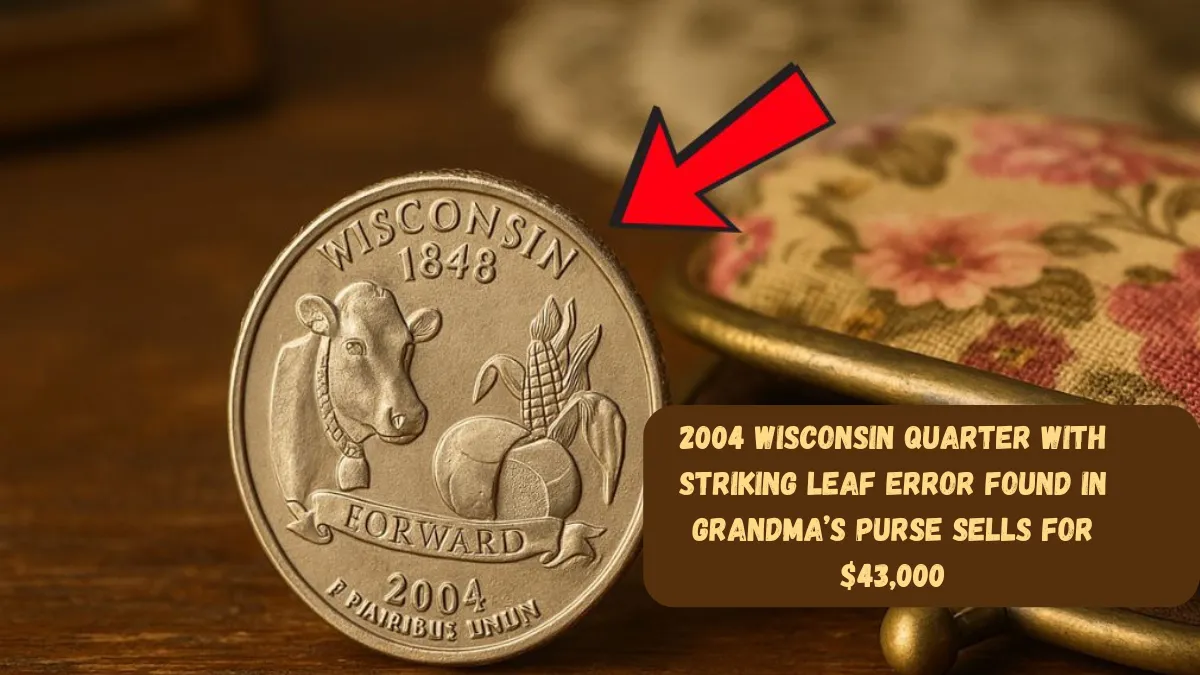In an unexpected turn of events, a rare 2004 Wisconsin State Quarter featuring a High Leaf error was discovered in a grandmother’s purse and later sold for an astonishing $43,000.
This extraordinary find has sparked renewed excitement among coin collectors and hobbyists, showcasing how significant value can sometimes be found in ordinary coins.
The 2004 Wisconsin Quarter and Its Unique Error
The 2004 Wisconsin State Quarter was released as part of the U.S. Mint’s 50 State Quarters Program, which ran from 1999 through 2008. The reverse side depicts symbols of Wisconsin’s farming heritage—a cow, a wheel of cheese, and an ear of corn.
However, certain quarters minted in Denver (identified by a “D” mint mark) display a distinctive flaw known as the “Extra Leaf” error. This flaw appears as an additional leaf on the left side of the corn stalk, which is not part of the original design.
Types of Extra Leaf Errors
There are two known forms of this anomaly:
High Leaf: The extra leaf is positioned above the main leaf on the corn stalk.
Low Leaf: The extra leaf is located below the main leaf.
These mistakes likely resulted from unintentional die damage during production, though some theories suggest they could have been deliberate modifications by someone at the mint.
The $43,000 Discovery
The coin that sold for $43,000 was a 2004-D Wisconsin State Quarter exhibiting the High Leaf error. Found in a grandmother’s purse, this discovery highlights how valuable coins might still be hiding in everyday money. Its rarity and excellent condition were key factors driving the impressive auction price, ranking it among the most valuable quarters ever sold.
Value and Rarity of Extra Leaf Quarters
The worth of these error coins depends on their condition and error type. Estimated values are:
High Leaf: $50 to $200+
Low Leaf: $20 to $50+
Exceptional Specimens: Up to $6,000 or more
For instance, a 2004-D Wisconsin quarter with a High Leaf error sold for $2,530 in 2006, and another Low Leaf variant fetched $6,000 in 2020.
How to Identify an Extra Leaf Error
To check if you have one of these rare quarters:
Look for the Mint Mark: It should have a “D” indicating Denver minting.
Examine the Corn Husk: On the back, observe the left side of the corn stalk for an extra leaf.
If the leaf is above the main leaf, it’s a High Leaf error. If below, it’s a Low Leaf error.
A magnifying glass can help spot these small details.
Tips for Collectors
Regularly check your change and coin collections for 2004 Wisconsin quarters. Handle suspected error coins gently to maintain their condition. Have them professionally appraised by a trusted coin dealer or grading service to confirm authenticity and value.
The $43,000 sale of the 2004-D Wisconsin State Quarter with the High Leaf error is a powerful reminder that valuable surprises may be lurking in everyday currency. Whether you’re an experienced collector or just starting out, taking a closer look at your coins could uncover a hidden treasure.
FAQs
What causes the Extra Leaf error on the 2004 Wisconsin quarter?
It is believed to be the result of accidental die damage or gouges during the minting process, though some speculate it could have been intentional.
How can I tell if my quarter has a High Leaf or Low Leaf error?
Check the extra leaf’s position on the corn husk: above the main leaf is High Leaf; below is Low Leaf.
Are all 2004 Wisconsin quarters with a “D” mint mark valuable?
No, only those with the Extra Leaf error tend to have significant value. Regular quarters are generally worth face value.
Where can I get my coin professionally appraised?
You can visit reputable coin dealers, grading services like PCGS or NGC, or attend coin shows where experts can evaluate your coin.
